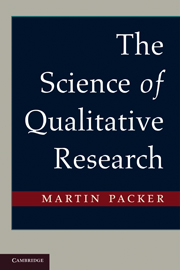Book contents
- Frontmatter
- Contents
- List of Figures and Tables
- List of Boxes
- Acknowledgments
- Introduction
- Part I The Objective Study Of Subjectivity
- 1 What Is Science?
- 2 The Qualitative Research Interview
- 3 The Analysis of Qualitative Interviews
- 4 Hermeneutics and the Project for a Human Science
- 5 Qualitative Analysis Reconsidered
- Part II Ethnographic Fieldwork – The Focus On Constitution
- Part III Inquiry With An Emancipatory Interest
- References
- Name Index
- Subject Index
5 - Qualitative Analysis Reconsidered
- Frontmatter
- Contents
- List of Figures and Tables
- List of Boxes
- Acknowledgments
- Introduction
- Part I The Objective Study Of Subjectivity
- 1 What Is Science?
- 2 The Qualitative Research Interview
- 3 The Analysis of Qualitative Interviews
- 4 Hermeneutics and the Project for a Human Science
- 5 Qualitative Analysis Reconsidered
- Part II Ethnographic Fieldwork – The Focus On Constitution
- Part III Inquiry With An Emancipatory Interest
- References
- Name Index
- Subject Index
Summary
[A]n interpreter can no longer claim to teach the reader the meaning of a text, for without a subjective contribution and a context there is no such thing. Far more instructive will be an analysis of what actually happens when one is reading a text, for that is when the text begins to unfold its potential; it is in the reader that the text comes to life. . . . In reading we are able to experience things that no longer exist and to understand things that are totally unfamiliar to us; and it is this astonishing process that now needs to be investigated.
Iser, 1980, p. 19We have seen that standard practice in qualitative research – semistructured interviews followed by analysis through coding – embodies contradictory ontological commitments and notions of subject and object and of subjectivity and objectivity. On the one hand, each person is assumed to be a separate individual with personal and private experiences, beliefs, thoughts, and desires. On the other hand, scientific knowledge is assumed to be objective and general, impersonal and detached, with all personal elements eliminated. How, then, can scientific knowledge be derived from subjective experience?
The qualitative research interview also draws confusingly from two models of language: discourse as a joint construction and language as a conduit. In the conduit model, what someone says is an “expression” of their experience or subjectivity. In the joint practice model, what is said is a product of two people, interviewer and interviewee. The semistructured interview uses the collaborative resources of language asymmetrically to render the interviewer invisible and encourage “disclosure” by the interviewee. The interviewee is encouraged to contemplate and reminisce about a topic outside the here and now, to confess to a patient but skeptical listener. In this respect, the interviewee’s subjectivity is an effect of the semistructured interview, not a preexisting, independent personal experience that is the content expressed in what is said.
- Type
- Chapter
- Information
- The Science of Qualitative Research , pp. 99 - 120Publisher: Cambridge University PressPrint publication year: 2010



